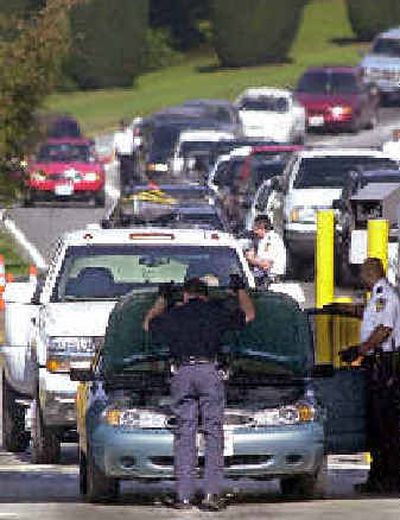Government to tighten security at Canadian border

Border guards at busy northern crossings will start fingerprinting foreign visitors by the end of the year as the Department of Homeland Security clamps down on the Canadian border.
Technology, including motion-detecting sensors and land- and air-based surveillance of deserted stretches, will also improve security, Asa Hutchinson, undersecretary for border and transportation security, said at a Minneapolis conference of law enforcement officials from eight Midwestern and Western states and Canada.
Fewer foreigners cross into the United States from Canada than from Mexico, but they are from more countries and come for a wider variety of reasons. The Homeland Security Department aims to expand the collection of fingerprints and other digital biometric data to the 50 busiest land crossings by the end of the year. Fingerprinting has already started at Mexican border crossings in Arizona, Texas and California.
“The fact still is that a terrorist, and the terrorists of 9/11, came in not sneaking across a land border but with documentation at a port of entry,” Hutchinson said. “That is obviously their preference. We have to continue to work on our ports of entry.”
The fingerprinting technology, already used at airports and seaports, will be extended to all land border crossings by the end of 2005. Most Canadians won’t be subjected to the scans because they don’t need a visa to enter the United States.
The conference, which included representatives of tribal governments and the Royal Canadian Mounted Police, was closed to media except for Hutchinson’s speech and a brief question-and-answer with reporters.
Tighter security at border crossings may lead terrorists to find other ways to enter the country, Hutchinson said.
The 5,525-mile Canadian border has one U.S. border guard for every 10 watching the Mexican border, Hutchinson said. His department has given grants to pay border guards overtime to increase patrols, resulting in a “historic level of security for the northern border,” he said.
Unmanned aerial vehicles, now being used to patrol the Mexican border, may be added on the Canadian border, he said. But there’s no substitute for citizens who live near the border who spot and report suspicious activities, he said.
Of $2.5 billion in homeland security grants distributed last Friday, $243 million went to eight states on the Canadian border, from Michigan westward to Washington and Alaska.
The House bill overhauling U.S. intelligence activities would authorize more border guards, technology and space to detain apprehended foreigners, Hutchinson said. The bill also creates federal standards for state driver’s licenses and identification cards.
Officials from Alaska, Idaho, Michigan, Minnesota, Montana, North Dakota, Washington and Wisconsin attended the conference.